Plants growing in between pavers (brick, concrete slabs, or stones) not only look good against the paving material, but they also soften hardscapes. Plants link between paving and adjacent perennial beds or other plantings. The fragrance is another contribution plants can make; when one walks among plants such as thyme or chamomile, fragrant oils are released. Interesting contrasts develop, too: the difference in texture and color between plants and paving materials.
Table of Contents
Choosing Plants for pavers
If you have brick paving, consider plants that will complement the color of the brick. For example, the blooms of Geranium sanguineum Ballerina have brick red striations that would blend the two colors nicely. Another combination near brick might be the red-leaved barberry underplanted with Polygonum affine and Heuchera Palace Purple. The gray-green color of Nepeta siberica complements a slightly grayish gravel. Or you could create a strong contrast between the paving material and the foliage and flowers of plants near it. Gray-leaved plants such as snow in summer (Cerastium tomentosum), and many dianthus. Artemesia ‘Powys Castle,’ edelweiss (Leontopodium alpinum), or Santolina chamaecyparissus would contrast nicely with dark red brick.
If you have existing paving that looks expansive and featureless, consider taking up sections or even breaking sections of the paving with a hammer and chisel to open up planting holes. Excavate the gap with a trowel and then fill it with soil appropriate to the plant you want to set in.
Plants can also be set into steps to soften their hard edges and link them with surrounding plantings. The only maintenance needed is to clip the plants back occasionally to keep the treads reasonably clear. Once you get plants established, the amount of weeding is reduced because the perennial invariably fills the gaps, thus preventing weed seeds from taking hold.
Establishing plants in gaps
Plants other than alpines do flourish in richer soil. You could fill the green joints with equal sand and topsoil to which some compost has been added so that the soil will drain well yet have organic content sufficient to sustain growth.
Replant seedlings from your beds into the gaps. Place an openwork wooden bushel basket over the seedling or set up stones or concrete blocks on the steps and place boards on them to shade the newly transplanted seedlings for a few days. This shade will also keep the rocks cool and thus hold more moisture in the soil.
Use pine needles as mulch to keep the sun’s rays off the soil and to hold moisture in the soil around the young seedlings or transplants until they become established after two or three weeks.
Moss in the Gaps
Moss is an especially good plant for gaps between stones in a shady path.
Collected moss sections survive transplanting best if taken when wet with rain. Keep the moss moist until they are ready for planting.
Prepare a site by uprooting all existing plants and watering the soil until it muddies. Spray the underside of the moss path with water before gently pressing it into the new site. Moss can be stretched slightly to fit the space, but if gaps remain, fill them in with soil a week later.
Compost tea (compost extract) makes a good, all-purpose fertilizer. This can be applied in the spring and early summer, at intervals of a few weeks.
Gardens and ground covers of moss are not carefree. They must be hand weeded and they need careful attention to watering. If grown in high-traffic areas, moss wears down and must be replaced periodically.
Propagating Moss
Propagating moss is a little tricky.
Prepare a shallow flat by lining the bottom with either very fine screening or slitted newspaper. Pour in an inch of a growing mix of equal parts fine sand and ground peat moss or sawdust. Level the mix and cover it with dampened cheesecloth.
Crumble pieces of dried moss and sprinkle them evenly over the cheesecloth. Cover that layer with a second piece of cheesecloth that is cut slightly larger than the flat and tuck in the edges.
Water the flat by sprinkling gently but thoroughly. Keep this seeded flat shaded and moist for 6 to 8 weeks. When the moss grows through both layers of cheesecloth, it is ready to be lifted out carefully and planted where needed. The cloth rots away in time.
Recommended Plants
I have divided the material into two categories;
- Sun loving plants
- Shade plants
Full sun plants
Plants that take abuse;
- Acaena buchananii: 2-inch mat-forming hardy perennial with small grayish-green foliage. Thrives in well-drained sunny sites but will burn in hot sun
- Acaena microphylla: 2-inch prostrate mat of yellow-bronze foliage; large red burrs follow inconspicuous flowers
- Alchemilla mollis (lady’s mantle): Gray-green hexagonal leaves with chartreuse flowers in summer
- Alchemilla alpina (dwarf lady’s mantle): 4 to 6-inch alpine form with greenish-yellow flowers in late spring.
- Arabis spp. and cultivars (rock cress): Appreciate well-drained soil in partial shade.
- Arenaria montana (sandwort): 4″-6″ mat-forming plant blooming white from late spring into early summer; does need reliably moist soil in full sun
- Campanula rotundifolia (harebell): 6″-10″; leaves green; broad bell-shaped bright blue flowers July and August
- Cerastium tomentosum (snow-in-summer): Gray-leaved, white flowers in early summer; requires good drainage
- Erigeron speciosus var. macranthus (Aspen daisy): Small, daisy-like flowers
- Gypsophila repens (baby’s breath): 6″-9″ high trailing stems with clusters of small white or pink flowers in summer
- Hippocrepis comosa (horseshoe vetch): Forms 3″-high mats with sweet pea-like golden yellow flowers in spring; tolerates drought and poor soil; good to hold soil around steps
- Mazus reptans (mazus): 1″ creeping mats with lavender flowers in May-June; very vigorous with 1″ leaves
- Phlox subulata (moss phlox): Stiff, needle-like evergreen leaves on creeping stems; forms 6″ mats with flowers ranging from white, pink, rose to lavender blue in early summer
- Phyla nodiflora (lippia): Flat, ground-hugging mat; a lawn substitute with gray-green leaves; lilac-rose flowers spring to fall; good in desert areas
- Sagina subulata (pearlwort or Irish moss): A dense, mat-forming perennial that forms 5″ flowering stems (Cultivar ‘Aurea’-called Scotch moss has yellow-green leaves); both need good soil, drainage, and ample water.
- Saponaria ocymoides (Rock soapwort): a 3″-6″ spreading perennial with bright pink flowers in summer, it can be walked on primarily because it spreads rapidly
- Sedum dwarf types: These low, drought-tolerant plants won’t withstand tromping, but along the edges of a path in full sun plants such as Sedum acre var. aureum, with its yellow flowers and carpet-like foliage will satisfy.
- Thymus pseudolanuginosus (wooly thyme): 2″ silver gray mats; lavender flowers in May June.
- T. praecox ‘Albus’: Emerald green mats with white flowers in May-June.
- Vinca minor ‘Miss Jekyll-white flowers and “Bowles-blue flowers (periwinkle or myrtle): These cultivars, particularly ‘Jekyll, are tolerant of full sun though they do like rich soil; tough and drought tolerant
- Zoysia tenuifolia: Creeping fine-textured mounding grass/ground cover that creates a mossy, Japanese effect; likes sun but tolerates some filtered shade





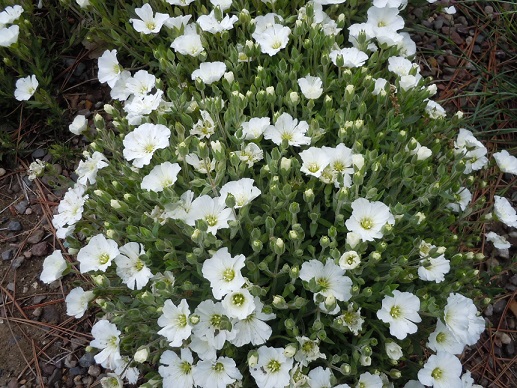
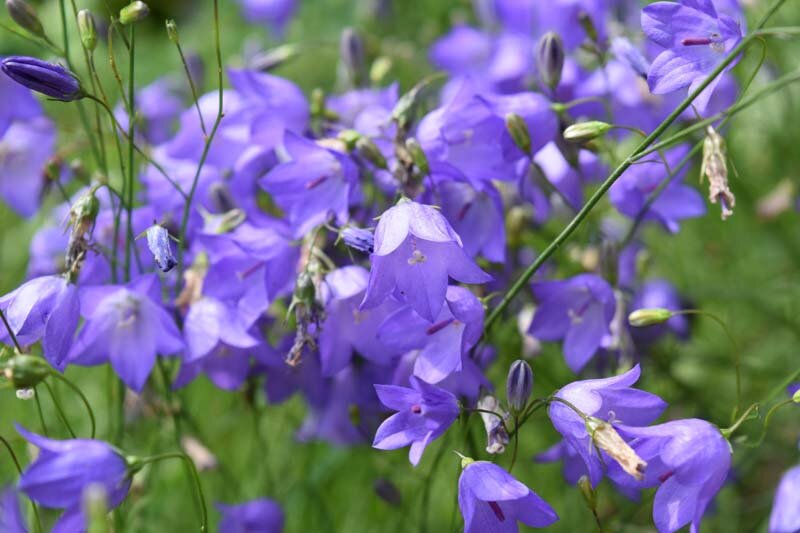






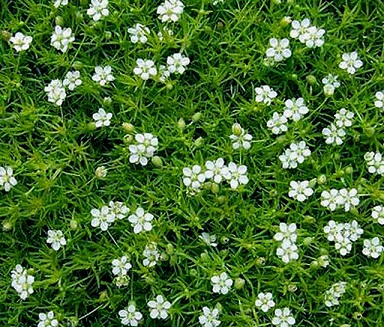




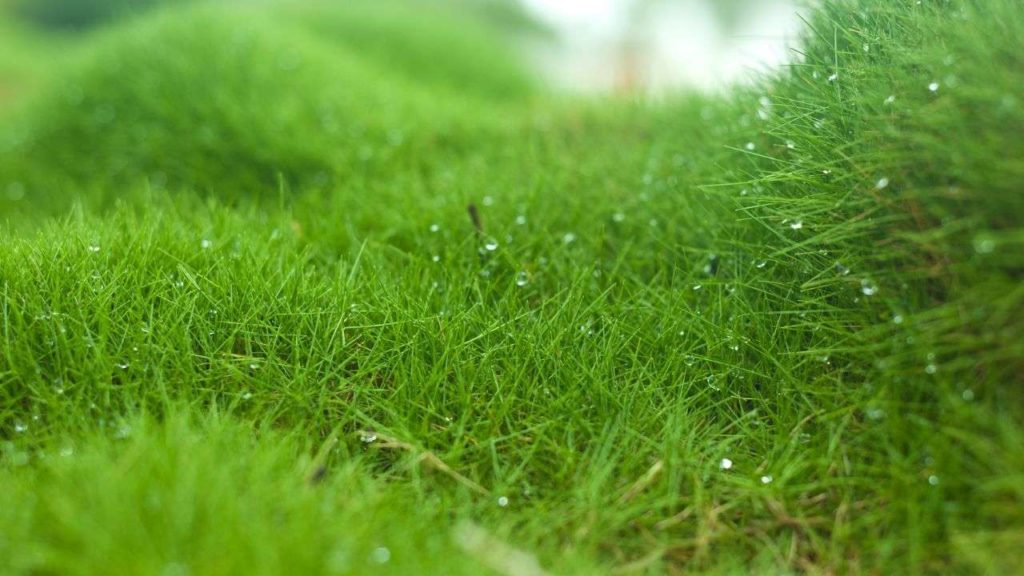
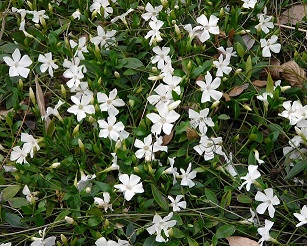
Fragrant plants:
- Chamaemelum nobile (chamomile): Forms 3″-6″ mats of lacy leaves; yellow flowers in late summer; the fragrance of apples when crushed
- Dianthus gratianopolitanus ‘Old Spice (Cheddar pink): Double-fringed salmon pink, very fragrant; great in steps out of harm’s way of one’s feet; highly perfumed, shaggy, double-white
- Geranium macrorrhizum “Ingwerson’s Variety’ (cranesbill): Highly scented leaves that form a 10″-12″ mounded perennial with pink flowers in late spring
- Malcomia maritima (Virginia stock): 6″-9″ annual; seeds will give rise to plants with mixed colors: lilac, pink, red, white; sweetly scented
- Mentha requienii (Corsican or creeping mint): Creeping or mat-forming 1/2″ mat to create a mossy effect; tiny light purple flowers and round, bright green, tiny leaves; needs partial shade and a rich evenly moist soil; minty, sage-like fragrance when walked on
- Thymus citriodorus (lemon thyme): Lemon-scented; variegated gold and green leaf; lavender flowers in late spring; ‘Aureus, gold variegated leaves; ‘Doone Valley, golden highlights on foliage
- Thymus herba-barona (caraway thyme): 4″-5″ wiry, prostrate stems form dark green mats with rose-pink blooms in May-June; caraway fragrance when stepped on
- Thymus serpyllum (mother of thyme): 2″-6″ high; dark-green aromatic leaves form dense green mats with cerise flowers






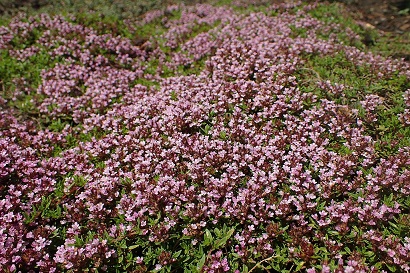

Low plants that can’t take a lot of abuse
Good for setting in risers of steps or at the edges of steps or pathways. Alpines and thousands of other rock garden plants are suitable for such a setting.
Consider androsaces, saxifrages, arabis, Dianthus alpinus, Campanula portenschlagiana, armerias, arenarias, Raoulia lutescens, Sedum spathulifolium ‘Capa Blanca’ and other low se- dums.
- Achillea tomentosa ‘Aurea’ (wooly yarrow): Lacy, ground-hugging gray-green foliage with yellow flower heads on 8″ stems in May-June
- Achillea tomentosa ‘King Edward VIII: Pale yellow flowers on 10″ stems in May-June with lacy green foliage.
- Aethionema warleyense (stone cress): 3″-8″ low, bushy plant topped with clusters of rose-pink flowers; light soil, excellent drainage in full sun; foliage bluish-gray
- Antennaria dioica rosea (pussytoes): Flat gray mat with pink pussytoe-like flowers in May; requires excellent drainage
- Arctostaphylos uva-ursi (bearberry): A woody, prostrate ground cover with small shiny bright green leaves that turn red in winter; likes sandy soil
- Armeria maritima (thrift): Narrow stiff leaves in compact tufts, white, pink, or rose globe-shaped flowers on 8″-10″ stalks over much of the season
- Aubretia deltoides ‘Red Carpet: 3″-4″, spreading, with gray-green leaves, flourishes in well-drained limey soil in full sun; blooms deep red in spring; cut back after flowers have faded to keep it neat
- Chrysogonum virginianum (golden star): 5″ carpet of yellow on green all summer, likes soil surface damp
- Draba sibirica: Prostrate foliage, yellow flowers in April and again in October
- Iberis sempervirens (evergreen candytuft): About 10″ high, narrow-leaved evergreen; dense white blooms in mid-spring
- Oxalis adenophylla: 4″ high tufts of crinkly, gray-green leaflets with lilac-pink flowers on 4″-6″ stalks in late spring; good drainage in full sun
- Oxalis hirta: Drought tolerant; in late fall bright rose pink flowers over clover-like leaves; plant bulbs in fall
- Sempervivium tectorum (hens and chickens): Rosettes of succulent leaves 4″-6″ across; very few ungainly flowers on 4″-8″ stems





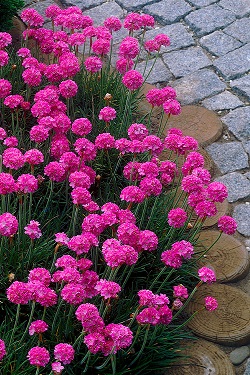


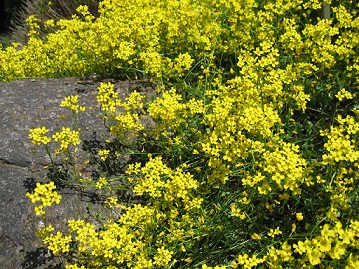




Full or Partial shade
Plants that will take a lot of abuse:
- Ajuga reptans (bugleweed): There are many cultivars, all low to the ground with 4″-6″ flower stems that bloom in May in blue, white, or pink, leaves can be shiny dark green, bronze, crinkly, variegated white, and green or variegated white, pink and purple.
- Alchemilla mollis (lady’s mantle): 1′-2′ high plants that will tolerate a great deal of shade
- Cornus canadensis- renamed Chamaepericlymenum canadensis (bunchberry): 6″ hardy carpetlike perennial that enjoys moist, peaty woodland soil; tiny clusters of white blooms in May and June followed by red berries. In autumn, leaves become burgundy red. Will tolerate dry shade as well
- Cotula squalida (New Zealand brass buttons): Evergreen leaves are soft fern-like bronze green 2″-3″ high; flowers like tiny brass buttons, will tolerate sun as well as medium shade
- Dichondra micrantha (dichondra): A ground-hugging plant (and lawn substitute) with leaves shaped like miniature water lily pads; will tolerate sun as well; sow seed in April or May around stepping-stones
- Gaultheria procumbens (wintergreen): A native groundcover, to 6″; creeping stems with shiny leaves with tiny white flowers in summer followed by scarlet berries
- Mitchella repens (Partridgeberry): Native, to 3″; very small, rounded evergreen leaves, light pink flowers, and red berries in fall
- Polytrichum commune (common haircap moss): A moss found worldwide; excellent for gathering around stepping-stones in woodland settings; tolerant of a wide range of light and moisture conditions; the toughest, most versatile of the mosses; zone hardiness not established
- Saxifraga stolonifera (S. sarmentosa) (strawberry geranium): A creeping plant that makes runners like strawberries; roundish, white-veined leaves 4″ across, white flowers; moist soil essential.
- Tiarella cordifolia (foamflower): 6″ high; white flowers that bloom in spring over heart-shaped leaves along creeping stems
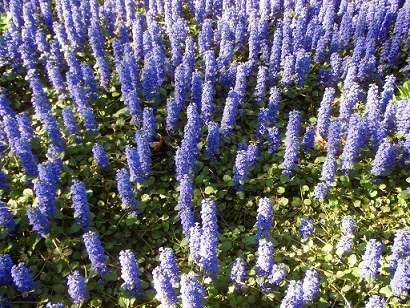

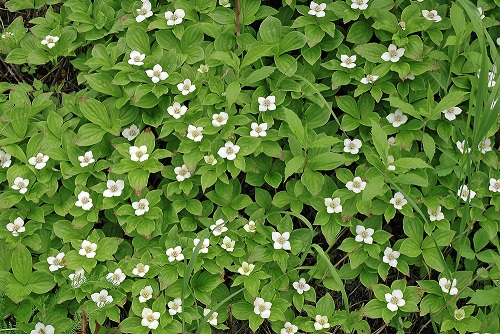

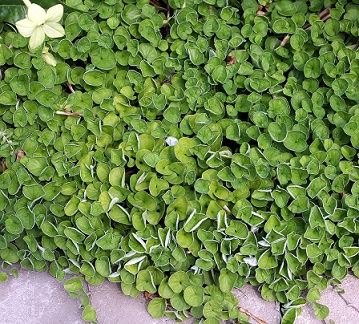


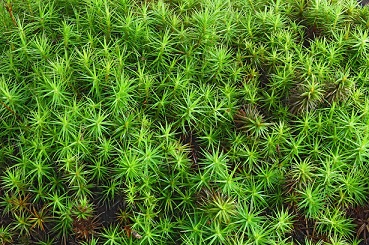


Plants that won’t take much abuse
- Asarum europaeum (European ginger): 3″-4″ ground cover with glossy, heart-shaped, evergreen leaves
- Astilbe hybrids: ‘Inshirach Pink’: 10″ pale pink spikes over dark bronze-green foliage in July-August
- Sprite: 12″ pale pink spikes over dark lacy foliage
- Bellis perennis ‘Pomponette’ (English daisy): Rosettes of dark green leaves 1″-2″ long; mixed pink, rose, white, or red daisy flowers in spring and early summer to 6″
- Chrysogonum virginianum (golden star): Long, triangular-toothed leaves; bright yellow, daisy-like, long-blooming flowers; to 6″
- Hostas: There are many varieties, but if you choose any, choose the smallest, so they snug into the risers in steps or along the edges of shady paths made of stepping stones.
- Soleirolia soleirolii (baby’s tears or angel’s tears): A tiny-leaved carpeting plant 1″-3″ high for around stepping-stones, for example; leaves and stems easily injured but quickly rejuvenates itself
- Viola cornuta (violets): Tufted plants 6″-8″ high with oval leaves; well-drained, cool conditions will give rise to the range of flowers available in this common plant
- Viola labradorica (species of violet): Hardy perennials with purple-tinted mats of foliage and mauve flowers in spring; slightly moist conditions, though it will tolerate dry conditions










